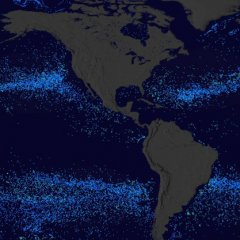SeaKeepers offers free digital lesson plans for K-12+ designed to make environmental conservation and social responsibility engaging and accessible. Topics include marine ecology, chemical oceanography, pollution, coral reefs, polar regions, and sailing. Each lesson varies in length, depth, and recommended age group. Browse the full collection and download lesson plans.
World Ocean Curriculum - Plastic and the Ocean

Ocean School is a free environmental education resource for students in grades 5-12. Inspiring and immersive multimedia resources featuring linear and 360˚ videos, VR/AR, interactive media and hands-on projects and activities are offered in English and French. Cross-curricular content spans science, social studies, language arts and more.
The National Marine Sanctuary Program aims to provide teachers with resources and training to support ocean literacy in America's classrooms. Lesson plans, exciting activities for students, possible research projects, and extensive background information for teachers. Grades 3-12.
The Washed Ashore Project uses art to communicate about the health of the ocean. They share curriculum and resources on ways to educate students about plastic pollution in the ocean and in waterways and to spark positive change in consumer habits. Curriculum topics include active collaborative projects, use of visual elements and principles, the science of plastics, lessons on oceanography and ocean-based transport, lessons on prevantative behavior, social science and language art reflection, and much more.
Educators can download an assortment of puzzles, brain-teasers, coloring activities, and formal curricula including marine debris monitoring toolkits for grades 1-12. All marine debris curricula and activities are available for download and print.
A collection of information and classroom activities covering: oceans, human impact, weather, satellite imagery, remote sensing, Antarctica, global climate change, lobsters, turtles, freshwater issues, and more.
Educational wall charts, graphics and maps available for environmental and earth science educators. Topics include impacts of climate change, animals affected by climate and at risk of extinction, global ecology, fresh water, pollution, and more.
Maine.gov curriculum module examines several key human connections to the ocean. Topics include activism/advocacy, climate change, ecosystems, nature, and social awareness. It will show students how to make a difference, how to understand the science and our relationship with the ocean, and ends with journaling and a community service art activity. For grades 9-12

